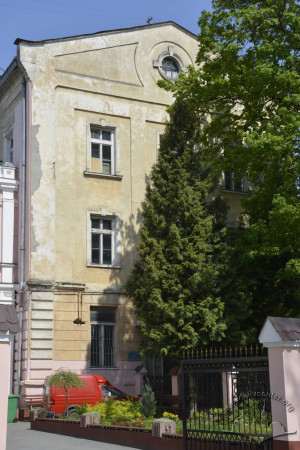Vul. Pekarska, 59 – former church of the Resurrectionist Congregation monastery ID: 2446
The building was erected as the church of the Resurrectionist Order monastery in 1888-1890 under a project designed by architect Albin Zagórski. It is an example of the Historicist architecture with the use of Neo-Renaissance and Neo-Romanesque motifs as well as with some Neo-Baroque elements. The church is an architectural monument (protection number 1649). Now it is a Protestant church of Christ the Savior belonging to the Ukrainian Christian Mission of Mercy Revival.
Story
The construction of the church as the monastery chapel started under a project designed by Albin Zagórski in 1888. According to unconfirmed reports, the project works were also joined by Łukasz Bodaszewski. In some old guidebooks 1887 is mistakenly indicated as the date of the church construction. In fact, the construction was completed in 1889. In November of the same year the church was consecrated. In 1890 the floor was laid. In 1891, under a project designed by Jan Tomasz Kudelski, the main altar was made by sculptor Piotr Harasimowicz.
Next time some works were carried out in 1931-1932. The flèche was given a new top according to a project designed by Wawrzyniec Dayczak. At the same time a new pediment was arranged on the north façade. The interior was painted by Kazimierz Smuczak and Stanisław Erenfeld. It was also Smuczak who created an original composition "Beheading of John the Baptist" at the choir loft free of charge.
In 1945 the Resurrectionist monks left Lviv. Since 1994 the former Roman Catholic church has functioned as a Protestant church, now it is the church of Christ the Savior belonging to the Ukrainian Christian Mission of Mercy Revival. In 1992-1994 a group of artists led by Roman Dovhanyk restored the interior murals.
Architecture
The church is the main building of the monastic buildings complex. Due to its slender tower it forms a distinct accent of the housing on the odd side of Pekarska street in its upper eastern segment. The building is located in the south-east part of the ensemble. From the west the church is connected with the former monastery building while from the north and north-west it is connected with the seminary building. The church’s east façade overlooks a small green area, separated from the street by a fence with brick columns.
The church is built of brick and plastered; it is close to a rectangle in plan, with the avant-corps of the former chapel in the east and that of the chancel in the north. The church consists of two parts: the nave and chapels flanking it. The nave is expanded by the choir loft from the south and west. In the south-east corner, the volume of the tower is constructed. The nave is covered with cross vaults, the side parts are covered with semicircular vaults with lunettes. The nave space is marked out by massive pillars, separated by pilasters and topped with arches.
The building’s compositional accent is the main east façade with the corner three-tier octagonal tower and the avant-corps of the chapel in the middle, topped with a pediment. The tower is crowned with a hipped roof. The main entrance to the church is arranged on the axis of the tower. The arched windows and entrances to the church have trimmings. Above the entrances, there are round windows.
The façade overlooking the street has two tiers, five axes and a profiled projection in the middle. The windows on the façade and in the tower’s upper tier are arched and semicircular. At the frieze level, in the tympanum of the chapel’s fronton and under the tower’s hipped roof there is an arcature belt, which is one of the characteristic stylistic (Neo-Romanesque) elements of the church. The church’s north fronton with the letters symbolizing Christ rises above the former seminary building. The main building is covered with a mansard roof; the chapel’s double-pitch roof is covered with tin; the tower‘s hipped roof has four lucarnes.
The easel artwork has not survived. As regards monumental works, there are four oil compositions on the chapel wall, including "The Annunciation", "The shepherds’ bow", "The Presentation of the Lord" (c. 1900). On the vaults and on the nave walls one can see ornamental and symbolic compositions in the Art Deco style (Kazimierz Smuczak, Stanisław Erenfeld, 1932; restoration, 1994). A memorial table dedicated to priest Walerian Kalinka has been preserved in the church.
As regards the style of the church, the Neo-Renaissance is combined there with the Neo-Romanesque style, there are also some elements of the Neo-Baroque (the chapel fronton). This eclectic composition is proper to the creative style of architect Albin Zagórski, who represents the Lviv architectural school of the late 19th c.
Related buildings and spaces
People
Albin Zagórski (1846-1910) – an architect who designed
architectural projects in Lviv and other areas of Galicia.
Wawrzyniec Dayczak (1882-1968) – an architect, teacher, and political figure.
Walerian Kalinka (1826-1886) – a priest and historian who founded the Polish branch of the
Resurrectionist Order.
Kazimierz Smuczak – a
Lviv muralist, a student of Jan Henryk Rosen.
Łukasz Bodaszewski –
a physicist and architect, a probable co-author of the project.
Piotr Harasimowicz –
a sculptor.
Roman Dovhanyk – a
modern Lviv muralist.
Stanisław Erenfeld –
an artist.
Jan Tomasz Kudelski – an
architect.
Sources
- State Archive of Lviv Oblast (DALO), 2/2/2324.
- Betlej A., "Kościół p. w. Zmartwychwstania Jezusa Chrystusa oraz klasztor, seminarium i "Internat Ruski" ks. Zmartwychwstańców, Kościoły i klasztory Lwowa z wieków XIX i XX. Materiały do dziejów sztuki sakralnej na ziemiach wshodnich dawnej Rzeczypospolitej", Cz. I, Kościoły i klasztory rzymskokatolickie dawnego województwa Ruskiego, T. 12 (Kraków, 2004), 103-116.
- Lwów. Ilustrowany przewodnik (Lwów-Wrocław, 2001), 226.
- Miasto Lwów w okresie samorządu (Lwów, 1896), 344.
- Orłowicz M., Ilustrowany przewodnik po Lwowie (Lwów, 1925), 191.
- Історія храму Христа Спасителя, "Добрий самарянин".
- Мельник Ігор, Львівські вулиці і кам’яниці, мури, закамарки, передмістя та інші особливості королівського столичного міста Галичини (Львів: Центр Європи, 2008), 318-319.









